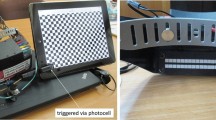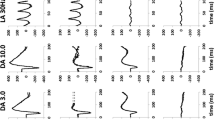Abstract
A system for recording electroretinograms and visual evoked cortical potentials has been constructed with the use of a personal computer and a digital signal processing card. The system is based on widely available commercial hardware. It has been designed to be capable of performing routine visual electrophysiology as well as allowing the development of novel visual stimuli and signal detection techniques. The system enables both transient and steady-state stimulation rates. Pattern stimuli can be presented in pattern-reversal, pattern-onset, pattern-offset or motion-onset modes. In addition to conventional signal averaging, the digital signal processing card can also provide on-line Fourier analysis and is facilitating the development of adaptive filtering techniques for the detection of steady-state visual evoked cortical potentials. This versatile system is in regular clinical use for the measurement of electroretinograms and visual evoked cortical potentials.
Similar content being viewed by others
Abbreviations
- ADC:
-
analog-to-digital converter
- DSP:
-
digital signal processing
- PC:
-
personal computer
- VGA:
-
Video Graphics Adapter
References
Carr RE, Siegel IM. Electrodiagnostic testing of the visual system: A clinical guide. Philadelphia: FA Davis Company, 1990.
Galloway NR. Ophthalmic electrodiagnosis, 2nd ed. London: Lloyd-Luke, 1981.
Heckenlively JR, Arden GB, eds. Principles and practice of clinical electrophysiology of vision. St Louis, MO: Mosby Year Book, 1991.
Spehlmann R. Evoked potential primer: Visual, auditory and somatosensory evoked potentials in clinical diagnosis. Boston, MA: Butterworth, 1985.
Barber C, Galloway NR. A pattern stimulus for optimal response from the retina. Doc Ophthalmol 1976; 10: 77–86.
Kubova Z, Kuba M. Clinical application of motion-onset visual evoked cortical potentials. Doc Ophthalmol 1992; 81: 209–18.
Kuba M, Kubova Z. Visual evoked potentials specific for motion-onset. Doc Ophthalmol 1992; 80: 83–9.
Hyvarinen L. Visual acuity testing principles. In: Heckenlively JR, Arden GB, eds. Principles and practice of electrophysiology of vision. St Louis, MO: Mosby Year Book, 1991: 459–64.
Taylor MJ, McCulloch DL. Visual evoked potentials in infants and children. J Clin Neurophysiol 1992; 9: 357–72.
Bradnam MS, Keating D, Montgomery DMI, Evans AL, Damato BE, Cluckie A. Steady-state visual evoked cortical potentials from stimulation of visual field quadrants: Optimizing pattern variables for the size of the field to be investigated. Doc Ophthalmol 1992; 79: 151–60.
de Waal BJ, Reits D, Spekreijse H, Grimbergen CA. Implementation of a portable pattern stimulator and VEP/ERG recording system based on an Apple microcomputer. Doc Ophthalmol Proc Ser 1983; 37: 209–16.
Epstein CM, Gammon JA, Gemmill M, Till J. Visual evoked potential pattern generation, recording, and data analysis with a single microcomputer. Electroencephalogr Clin Neurophysiol 1983; 56: 691–3.
Stanziano G, Kaplan H, Koblasz A, Davey K. Microcomputer analyses of clinical ERG, EOG and other tests of retinal function. Med Instrum 1988; 22: 12–9.
Torok B. Microcomputer-based recording system for clinical electrophysiology. Doc Ophthalmol 1990; 75: 189–97.
Winston J, Baker B, Heckenlively J. A low-cost automated evoked potential system [abstract]. Presented at the 29th Symposium of the International Society for Clinical Electrophysiology of Vision, Oxford, 1991.
Wilton R. Programmer's guide to PC and PS/2 video systems. Redmond: Microsoft, 1987.
Hayward M, Mills IM. Design effects of video pattern generators on the visual evoked potential. Barber C, ed. Evoked potentials. Lancaster: MTP, 1980.
Van Lith GHM, Van Marle GW, Van Dok-Mak GTM. Variation in latency times of visual evoked cortical potentials. Br J Ophthalmol 1978; 62: 220–2.
Van Lith GHM, Van Marle GW, Vijfvinkel-Bruinenga S. Interference of 50 Hz electrical cortical potentials produced by TV systems. Br J Ophthalmol 1979; 63: 779–81.
Barber C. Inherent characteristics of visual stimulus systems and their effect on the visual evoked potential. Clin Phys Physiol Meas 1981; 2: 135–46.
Marmor MF, Arden GB, Nilsson SEG, Zrenner E. International standardization committee. Standard for clinical electroretinography. Arch Ophthalmol 1989; 107: 816–9. Reprinted with permission in Doc Ophthalmol 1989; 73(4): 303–11.
Mutlukan EM, Bradnam MS, Keating D, Damato BE. Visual evoked cortical potentials from transient dark and bright stimuli: Selective ‘on’ and ‘off pathway’ testing? Doc Ophthalmol 1992; 80: 171–80.
Bradnam MS, Cluckie A, Damato BE, Evans AL, Keating D, Montgomery DMI. Adaptive filtering of steady-state visual evoked cortical potentials [abstract]. Presented at the 30th Symposium of the International Society for Clinical Electrophysiology of Vision, Vienna, 1992.
Author information
Authors and Affiliations
Rights and permissions
About this article
Cite this article
Bradnam, M.S., Evans, A.L., Montgomery, D.M.I. et al. A personal computer-based visual evoked potential stimulus and recording system. Doc Ophthalmol 86, 81–93 (1994). https://doi.org/10.1007/BF01224630
Accepted:
Issue Date:
DOI: https://doi.org/10.1007/BF01224630




